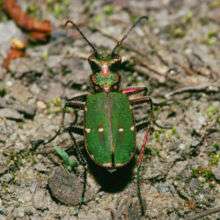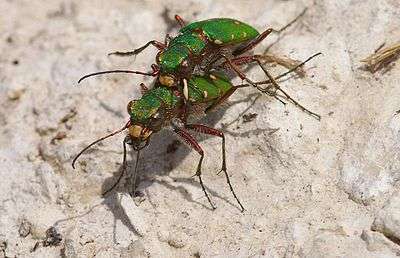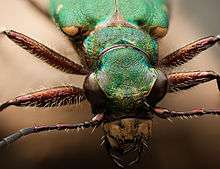Cicindela campestris
| Cicindela campestris | |
|---|---|
 | |
| Scientific classification | |
| Kingdom: | Animalia |
| Phylum: | Arthropoda |
| Class: | Insecta |
| Order: | Coleoptera |
| Family: | Carabidae |
| Subfamily: | Cicindelinae |
| Genus: | Cicindela |
| Species: | C. campestris |
| Binomial name | |
| Cicindela campestris Linnaeus, 1758 | |

Cicindela campestris, commonly called the green tiger beetle is a widespread Eurasian species of tiger beetle. It is the type species of the large genus Cicindela.
Adult
Adults are typically 12–15 millimetres (0.47–0.59 in) long. The elytra and thorax are green, varying in tone from light to dark, spotted with cream-coloured patches, and in bright sunlight are somewhat iridescent. The eyes are blackish; the legs are brown with whitish hairs. The antennae are long and straight, not clubbed.

Behaviour
The adults are sun-loving. They live in places with dry soils (sandy or chalky), mostly between May and October at the latitude of Britain. Like other tiger beetles, they run fast on their long legs and are most often seen on bare ground, in Britain typically on heather moorland. They can fly fast, making a loud buzzing noise.[1] It can run at speeds of 60 cm per second.[2]
Larva
The larvae are carnivorous. They dig burrows from where they ambush ground-living insects such as ants.[1]
Distribution
Cicindela campestris is distributed across Europe from Spain in the southwest to Finland in the northeast. Most records are from the UK, Germany, Austria and the south of Sweden. In Britain, records are mainly from dry sandy or heathy areas such as the heathlands of Surrey, Hampshire and Dorset, and the mountains and moorlands of the Scottish Highlands.[3]
Subspecies
The species is divided into several subspecies:
- Cicindela campestris atlantis Mandl, 1944
- Cicindela campestris balearica Sydow, 1934
- Cicindela campestris cyprensis Hlisnikowsky, 1929
- Cicindela campestris nigrita Dejean, 1825
- Cicindela campestris olivieria Brullé, 1832
- Cicindela campestris palustris Motschulsky, 1840
- Cicindela campestris pontica Fischer von Waldheim, 1825
- Cicindela campestris saphyrina Gené, 1836
- Cicindela campestris siculorum Schilder, 1953
- Cicindela campestris suffriani Loew, 1943
- Cicindela campestris calabrica Mandl, 1944
In culture and art
A piece of modern classical music by Stephen Andrew Rawle for clarinet, violin and piano is entitled Opus 43, Cicindela Campestris.[4]
Ecology
The mollicute bacterium species Entomoplasma freundtii (Entomoplasmatales, Entomoplasmataceae) can be isolated from the green tiger beetle.[5]
Notes
- 1 2 Chinery, M. page 110
- ↑ Wright, Jacqueline. "Beetles on Shotover" (PDF). www.shotover-wildlife.org.uk. Retrieved 23 October 2014.
- ↑ "Encyclopedia of Life". Cicindela campestris. EOL. Retrieved June 13, 2012.
- ↑ Rawle, Stephen Andrew (2011). "Opus 43, Cicindela Campestris, for clarinet, violin and piano.". Score Exchange. Retrieved June 13, 2012.
- ↑ Tully, JG; Whitcomb, RF; Hackett, KJ; Williamson, DL; Laigret, F; Carle, P; Bové, JM; Henegar, RB; Ellis, NM; Dodge, DE; Adams, J (1998). "Entomoplasma freundtii sp. nov., a new species from a green tiger beetle (Coleoptera: Cicindelidae)". International Journal of Systematic Bacteriology. 48 (4): 1197–204. doi:10.1099/00207713-48-4-1197. PMID 9828421.
References
Chinery, Michael. Collins Complete Guide to British Insects. Collins, 2005. ISBN 978-0-00-729899-0